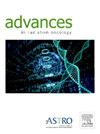Comparative Analysis of 68Ga-Prostate-Specific Membrane Antigen Positron Emission Tomography/Computed Tomography and Multiparametric Magnetic Resonance Imaging for Gross Tumor Volume Delineation in Radiation Therapy Planning of Prostate Cancer
IF 2.7
Q3 ONCOLOGY
引用次数: 0
Abstract
Purpose
Magnetic resonance imaging (MRI) with multiparametric assessment is a cornerstone in radiation therapy planning for primary prostate cancer (PCa), offering the potential for focal dose escalation to dominant intraprostatic lesions to enhance PCa management. The prostate-specific membrane antigen (PSMA), which is frequently overexpressed in PCa, has led to the development of 68Ga-labeled PSMA inhibitors for positron emission tomography (PET)/computed tomography (CT), showing promising results in PCa detection. This study aimed to conduct a comparative analysis of 68Ga-PSMA PET/CT and multiparametric MRI (mpMRI) in delineating the gross tumor volume (GTV) in PCa.
Methods and Materials
A retrospective analysis was performed on 25 PCa patients who underwent 68Ga-PSMA PET/CT and mpMRI at 2 distinct centers. The GTVs were delineated on MRI (GTV-MRI) by 2 nuclear medicine physicians and 1 radiation oncologist independently, while the GTVs based on PET/CT (GTV-PET) were outlined by 2 nuclear medicine physicians. The laterality (left, right, and bilateral) prostate lobes on mpMRI and PET/CT was assessed. To account for registration uncertainties, both GTV-PET and GTV-MRI were expanded isotropically by 5 mm to form the planning target volume (PTV), and the overlap between specific PTVs and their corresponding GTVs was quantified.
Results
The average ± SD GTV-MRI and GTV-PET were 5.468 ± 11.6 cm³ and 11.136 ± 14.3 cm³, respectively, with the GTV-PET being significantly larger than the GTV-MRI (P = .003). GTV-MRI exhibited an intersection with GTV-PET of 3.5 ± 6.0 cm³. The PTV derived from PSMA PET/CT encompassed 62% ± 27% of the GTV-MRI, with 44.4% of patients having the PTV covering 100% of the GTV-MRI. Conversely, the PTV based on GTV-MRI covered 50% ± 31% (mean ± SD) of the GTV-PET.
Conclusions
68Ga-PSMA PET/CT and mpMRI demonstrated consistent outcomes in 47% of patients (40%-54% of lesions). Notably, the GTV-PET was larger than the GTV-MRI, indicating a potential role for 68Ga-PSMA PET/CT in radiation therapy planning for targeted radiation delivery to PCa.
68ga前列腺特异性膜抗原正电子发射断层扫描/计算机断层扫描与多参数磁共振成像在前列腺癌放射治疗计划中大体肿瘤体积描绘的比较分析
目的磁共振成像(MRI)的多参数评估是原发性前列腺癌(PCa)放射治疗计划的基础,为主要前列腺内病变提供局灶剂量递增的潜力,以加强前列腺癌的管理。前列腺特异性膜抗原(PSMA)在前列腺癌中经常过表达,68ga标记的PSMA抑制剂用于正电子发射断层扫描(PET)/计算机断层扫描(CT),在前列腺癌检测中显示出令人鼓舞的结果。本研究旨在对68Ga-PSMA PET/CT与多参数MRI (mpMRI)对前列腺癌总肿瘤体积(GTV)的描绘进行比较分析。方法与材料回顾性分析25例PCa患者在2个不同中心接受68Ga-PSMA PET/CT和mpMRI检查。gtv由2名核医学医师和1名放射肿瘤学医师独立在MRI (GTV-MRI)上划定,基于PET/CT (GTV-PET)的gtv由2名核医学医师划定。在mpMRI和PET/CT上评估前列腺叶的侧位(左、右、双侧)。为了考虑配准不确定性,GTV-PET和GTV-MRI均向各向同性扩展5mm,形成规划靶体积(PTV),并量化特定PTV与其对应gtv之间的重叠。结果GTV-MRI和GTV-PET的平均±SD分别为5.468±11.6 cm³和11.136±14.3 cm³,GTV-PET明显大于GTV-MRI (P = 0.003)。GTV-MRI与GTV-PET相交为3.5±6.0 cm³。PSMA PET/CT的PTV覆盖GTV-MRI的62%±27%,44.4%的患者PTV覆盖GTV-MRI的100%。相反,基于GTV-MRI的PTV覆盖了GTV-PET的50%±31%(平均±SD)。结论68ga - psma PET/CT和mpMRI在47%的患者(40%-54%的病变)中显示一致的结果。值得注意的是,GTV-PET比GTV-MRI更大,这表明68Ga-PSMA PET/CT在前列腺癌靶向放射治疗计划中的潜在作用。
本文章由计算机程序翻译,如有差异,请以英文原文为准。
求助全文
约1分钟内获得全文
求助全文
来源期刊

Advances in Radiation Oncology
Medicine-Radiology, Nuclear Medicine and Imaging
CiteScore
4.60
自引率
4.30%
发文量
208
审稿时长
98 days
期刊介绍:
The purpose of Advances is to provide information for clinicians who use radiation therapy by publishing: Clinical trial reports and reanalyses. Basic science original reports. Manuscripts examining health services research, comparative and cost effectiveness research, and systematic reviews. Case reports documenting unusual problems and solutions. High quality multi and single institutional series, as well as other novel retrospective hypothesis generating series. Timely critical reviews on important topics in radiation oncology, such as side effects. Articles reporting the natural history of disease and patterns of failure, particularly as they relate to treatment volume delineation. Articles on safety and quality in radiation therapy. Essays on clinical experience. Articles on practice transformation in radiation oncology, in particular: Aspects of health policy that may impact the future practice of radiation oncology. How information technology, such as data analytics and systems innovations, will change radiation oncology practice. Articles on imaging as they relate to radiation therapy treatment.
 求助内容:
求助内容: 应助结果提醒方式:
应助结果提醒方式:


